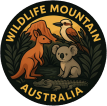MYOPATHY
When Fear Takes Hold: The Silent Struggle of Wallabies
Imagine a wallaby at dusk—the fading sunlight casting its coat in tones of russet, ash, and silver. This creature is poetry in motion, weaving gracefully between bush shadows. Its powerful hind legs, sculpted by evolution, propel it forward in great leaps, each bound a tribute to survival and freedom in the wild Australian landscape. The air carries the subtle scent of eucalyptus and the earthy perfumes of the undergrowth, while the soft rustle of dry leaves punctuates its balletic journey.
The Invisible Threat
But hidden dangers lurk in the twilight. Sometimes, it is not the flash of a predator’s teeth that seals a wallaby’s fate, but a darker, silent adversary: myopathy. This condition, triggered by overwhelming stress, is often set in motion when a wallaby flees from predators—most frequently, domestic dogs. What seems like an escape becomes, tragically, a race against an internal enemy.
Myopathy: When Survival Becomes Suffering
Myopathy, particularly rhabdomyolysis, is a medical crisis where intense physical effort and stress cause the breakdown of muscle fibres. The body’s own processes, fighting to survive a panicked escape, begin to betray the animal. The result: stiffness, paralysis, and a haunting stillness in what was once a vibrant, living being. Signs like unusual salivation and weakness appear within hours or days. The wallaby seeks solitude, retreating from the world as its body silently succumbs—most often within two weeks of the traumatic event.
To an observer, the story may seem to end with escape, but for the wallaby, it is often just the beginning of a hidden suffering.
The Ripple Effects of Unseen Wounds
| Threat | Visible Signs | Hidden Impact |
|---|---|---|
| Dog encounter | Harried escape | Muscle degeneration |
| Human activity | Startled flight | Long-term stress |
| Habitat loss | Displacement | Chronic anxiety |
As adrenaline surges and the wallaby bolts away, each leap imprints invisible scars. What appears as a victory over threat is overshadowed by a slow, unseen decline.
Guardians of the Night
Yet, hope glimmers like the southern stars. A simple act—securing pets, especially at night when native wildlife is most active—can dramatically rewrite this narrative. Responsible guardianship preserves the delicate dance of our nocturnal fauna and upholds the vibrant tapestry of the bush.
The Fragile Future: A Call for Compassion
In the gentle confines of a wallaby’s pouch, the next generation waits. For joeys, swift rescue and specialised care can offer a second chance at life. However, for many adults—like the 12-month-old Swamp wallaby in this poignant tale—help arrives too late.
The loss is more than individual; it is a fading note in the wild symphony of Australia.
How You Can Help
- Secure your pets at dusk and through the night.
- Support wildlife carers and organisations who rescue and rehabilitate native species.
- Educate others about the silent dangers faced by wildlife in our shared spaces.
As night settles over the bush and the stars twinkle high above, our actions resonate through the land. By choosing compassion and awareness, we help ensure that the wondrous ballet of macropods continues—alive, vibrant, and untarnished by preventable tragedy.
Let us all stand as stewards of Australia’s wild heart, protecting the delicate balance that lets life leap across our landscapes, free and unafraid.
For more information on supporting native wildlife, or advice on coexisting with nature in your region, reach out to local wildlife organisations or visit reputable conservation websites.
